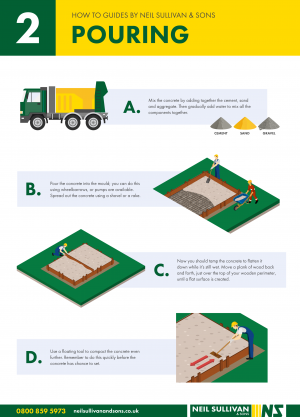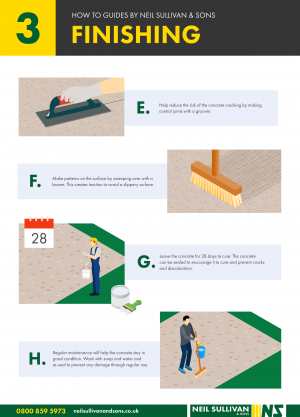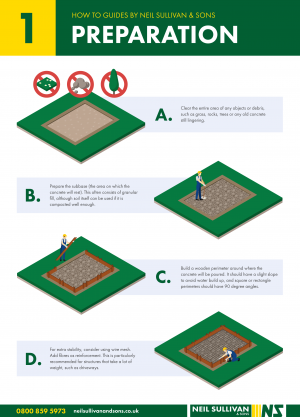Receiving Your Concrete Delivery
If you’re undertaking a DIY project at home that involves laying new concrete, such as foundations for a shed or patio or a new garden path or driveway, there are a few things you will need to do before your concrete arrives!
The first thing to check with your concrete suppliers is that you have enough space for them to park their truck safely. If not, you may need to hire a concrete pump to transport the concrete from the truck to the required location.
Secondly, speak to them about your quality requirements – the last thing you want is to pay an unnecessary part-load charge, or order more than you need and have to pay for disposal! Depending on your application, you may benefit from having your concrete mixed up on site, to ensure you only pay for what you need, or it may be more cost effective to opt for ready mixed concrete.
Tools for laying your concrete:
- Wooden formwork – hammer, nails, timber
- Spirit level
- Stone or aggregate for the sub-base
- Wheelbarrows (or, hire a concrete pump)
- Trowels and spades
- Wide plank of wood/tamping beam
- Polythene
Before the concrete arrives:
 The most important thing when laying new concrete for any application, from a simple pathway to a home extension, is to take the time to adequately prepare the ground and lay a sub base. This will give your new concrete structure a solid and long lasting foundation, and the best results.
The most important thing when laying new concrete for any application, from a simple pathway to a home extension, is to take the time to adequately prepare the ground and lay a sub base. This will give your new concrete structure a solid and long lasting foundation, and the best results.
Clear the way – The first job when laying concrete is to prepare the ground. Ensure it is as level as possible and any stones, old concrete or shrubs are all cleared away ready for the sub-base.
Lay the sub-base – Before you can pour the concrete, you should prepare an adequate sub-base to give the concrete a solid foundation. Usually loose granular fill or road base is best, and it should be properly compacted.
Build a frame – The frame, or form, is a wooden barrier around the edge of where you want to pour your concrete. The joints should be tight, and it should be deep enough to ensure your concrete won’t overflow.
Once your concrete arrives:
 If you need to wheelbarrow your concrete from the truck to the required locations, ensure you have enough hands on deck to help. Alternatively, if the pour location is too far for the truck’s chute to reach, hire a concrete pump to help with efficient and quick delivery.
If you need to wheelbarrow your concrete from the truck to the required locations, ensure you have enough hands on deck to help. Alternatively, if the pour location is too far for the truck’s chute to reach, hire a concrete pump to help with efficient and quick delivery.
Pour the concrete – as the concrete is being poured, pumped or wheelbarrowed into the form, it will need to be raked out to ensure an even surface.
Tamping – Once the concrete is in place, you can use a tamping beam (plank of wood) to compact and level the concrete for a smoother finish. You’ll need one person on each end of the tamping beam, first raise it up and gently bring it down on the concrete surface to compact it, and then use a sawing action backwards and forwards to level off the concrete.
Set the concrete – you should cover over the newly poured concrete loosely with polythene. This will stop the moisture escaping too quickly, allowing the concrete to properly cure and strengthen.
How long does concrete take to set?
Most types of concrete will be hard to the touch after just a few hours. After 3 hours, it will have set and gained 80% of its full strength, but it will take around 28 days to fully cure and reach its full strength.
- You should be able to walk on your concrete after 24 hours
- Light vehicles can be driven over the concrete at 7 days
- Heavy, or industrial vehicles or equipment should be restricted for 28 days
Some types of concrete can set at different rates, and the weather, temperature and humidity can affect how long it takes concrete to properly cure. You should also seek advice from your concrete suppliers for the best results.
Neil Sullivan & Sons
For any further information, or to speak to a specialist about your project today – simply contact the team at Neil Sullivan & Sons. With years of experience, we’ll be happy to offer advice and ensure you get all the info you need to lay flawless concrete.
